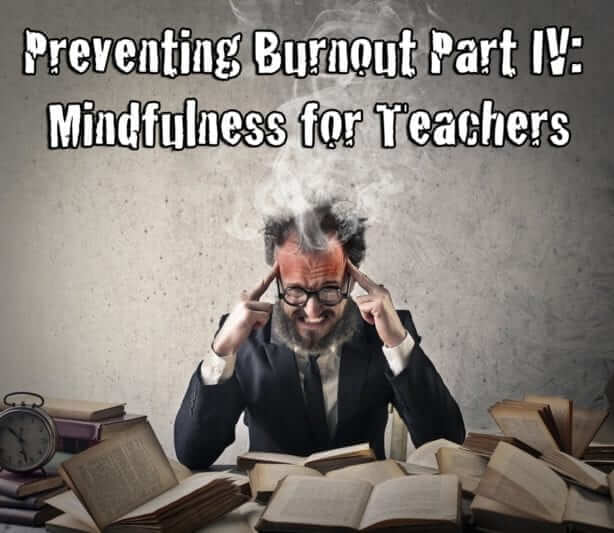Preventing Burnout: Part IV: Mindfulness for Teachers
The following is the fourth part of our “preventing teacher burnout” series presented by our colleagues at TeacherCoach.
Many of us have heard the time mindfulness, but it truly means, where it comes from, or how it applies to teaching are not always clear. Often times we hear of teachers playing some music, using quiet time (because we can’t call it meditation), or even implementing some yoga poses, which may be applications of mindfulness, but only an application of a deeper concept. How mindfulness can improve our work and even stave off mindfulness may be surprising.
The word sati, which we translate ‘mindfulness’, means ‘memory’, originally used by Brahmans to memorize Vedic scriptures. To effectively recall large bodies of text, they entered a zone of clarity and presence, free of distractions. This was one of the influences in developing what we today call ‘meditation’ and is the origin of mindfulness. So right off the bat we start to imagine how much the world has changed since then. Can you imagine being thirty feet from your cell phone, email, or computer for thirty minutes, much less memorize 3000 page tomes.
Zen Buddhism, the next evolutionary phase of mindfulness, is not a theory, an idea, or a piece of knowledge, not a belief, a dogma, or a religion; but rather, a practical experience. Zen does not require one to believe in anything, rather it shows us how to find peace with the world. You might contend that the founder of Zen didn’t have to work in modern day education and you would be right. Let’s now look further down the road at how mindfulness was blended with psychology, with the creation of gestalt therapy.
Therapy and teaching have important similarities. In both we seek to strengthen knowledge, tools, and awareness to help a person prepare and overcome challenges. In therapy, (gestalt), we creatively help a person look at internal and external processes to become more aware of what’s working to get their needs met, what obstacles are in their path, and what change would look like. In teaching we provide information, critical thinking, and techniques for solving social and intellectual problems.
In both therapy and teaching, if we bypass the learning process to focus on an end result, knowledge, we become more dependent on the instruction and less autonomous, putting more strain on the teacher. When we are pressured by need to achieve results, such as how many feel about standardized testing, creativity and freedom may be sacrificed. This is how veteran teachers in particular become susceptible to burnout. Mindfulness, in both teaching and therapy help us stay in the experience so we never lose sight of the process.
One could argue that the simple act of teaching a curriculum, leads people away from mindfulness, in particular if the topics addressed don’t resonate personally with the person doing the teaching. If a fifth-grade teacher named Sarah is using a common core technique called number bonds, but believes this is taking a simple math concept and making it more difficult, she may become tense, resentful, and stuck in her head trying to reconcile her incongruence.
Mindfulness helps us to be more present, allowing us to be more intentional and more peaceful (by less thinking and more experiencing). Mindfulness heightens our awareness through self–reflection, so we can monitor the messages our body sends us instead of interpreting them as symptoms. We stand a better chance of getting our needs met if we pay attention to our bodies, because our brain’s job is protection, not needs. By recognizing and acting on our needs, we won’t find ourselves growing a deep void that can lead to unhappiness and job dissatisfaction.
The teacher that eats when she is lonely or lashes out when he is feeling unloved, will use mindfulness to better negotiate their needs because they can quickly identify where the deficits are. These quick pivots toward our wants and needs will be essential if we are to prevent the deeper voids that lead to burnout.
This article is written by Jared Scherz, Ph.D., M.Ed. and CEO, of TeacherCoach a professional and personal teacher health site.






Comments are closed.